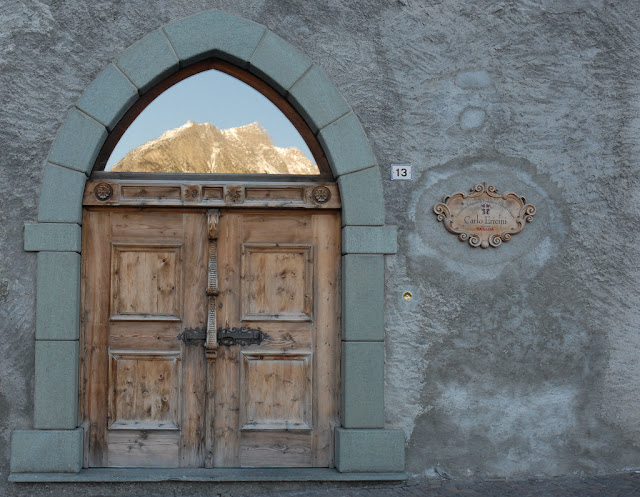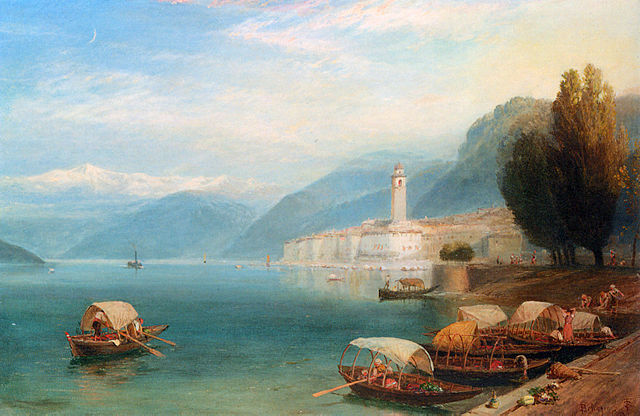Florence - Santa Croce
Day 11, 12 & 13 Exploring Florence
Known for its pure Gothic style, famous works of art and historical importance, it was begun in 1294
near the site of an earlier Franciscan church. Designed by Arnolfo di Cambio, it was consecrated in 1443. At that time, the Franciscan mendicant order was obliged to live an ascetic life without personal belongings, so they were dependent on generous donations from wealthy families. It was also these wealthy families who funded and donated the extensive works of art that decorate the interior of the church as a way to secure a prominent burial site for themselves inside Santa Croce.
In time, Santa Croce became known as a pantheon of important figures, fine arts, music and intellectual life. With the resting places of Michelangelo, Galileo, Machiavelli, Dante and Ghiberti, Santa Croce was nicknamed "Temple of the Italian Glories" and became a pilgrimage site for 19thC travelers in search of culture.
The Nave
The Altar and the Crucifix
The stunning Gothic interior has a long nave and two side aisles which are separated by slender octagonal piers with pointed arches. The golden altar features Madonna and the Saints. Above that is the Crucifix. Some of the stained glass is from 1380.
Patrons' Tombs
The entire length of the nave floor is covered with the grave markers of those wealthy
patrons, and the ceiling above is trussed with timber.
Funeral Monuments
On both sides of the long nave are the tombs of famous Italians.
Galileo Galilei
He was best known for his many contributions to astronomy and the invention of the telescope. However, after declaring that the sun was the center of the universe and the earth revolved around it, he was accused of heresy and placed under house arrest for the rest of his life. At his death, admirers were able to exert enough influence and raise enough money for him to be laid to rest in a prominent place directly across from the tomb of Michelangelo.
Michaelangelo by Vasari 1579
Regarded as the most famous artist of the Italian Renaissance, among his works are the "David" and "The Pieta" statues, as well as the frescoes on the Sistine Chapel ceiling. He died in Rome in 1564. Admirers reportedly stole his bones so he could be buried in Florence. The three allegorical statues, all in mourning, represent Sculpture, Painting and Architecture.
Machiavelli
He was an Italian diplomat who was best known for writing The Prince, a handbook for unscrupulous politicians. It inspired the term machiavellian (cunning and scheming) and established the author as "the father of modern political theory". The inscription reads, "No elegy is equal to such a man."
Dante Alighieri
The remains of Italy's greatest poet are buried in Ravenna, as he was exiled from Florence in 1302 for his political activities and was never allowed to return. When he died, the city refused to allow Florence to reclaim his body. Therefore, the tribute we see is a cenotaph - an empty tomb erected in honor of a person whose remains are elsewhere. On the right is "Poetry" mourning the loss of Italy's supreme poet. On the left, the statue represents Italy in tribute to Dante.
Baroncelli Chapel
Located at the end of the transept is the Gothic tomb of the Baroncelli family.
The golden lunette and the frescoes on the wall depict scenes of Mary's life.
Pathway leading to the Cloister and Museum
OPA - "Pray for Souls"
Piazzi Chapel & Museum Di S. Croce
The refectory, once the original dining room where friars shared their meals, is now the
museum. The white walls are accented by grey stone pilaster stripes.
Tree of Life
The centerpiece is the frescoed "Last Supper and the Family Tree of Christ" which depicts six different scenes. The Tree of Life is the central message of salvation as announced to the prophets. The fresco was severely damaged during the flood of 1966.
Crucifix
This enormous crucifix from 1290 is famous not only for its extraordinary quality but also for the fact that it, too, suffered irreparable flood damage.
Enjoy these videos of Santa Croce
https://youtu.be/3205efygryU
https://youtu.be/YpDhIkNXDow
Santa Croce - Basilica of the Holy Cross
"The vastness, the lightness, the open spring of the arches, the beautiful shape of the high and narrow choir, the impression made of mass without weight, gravity without gloom - these are my frequent delight." Henry James
"The vastness, the lightness, the open spring of the arches, the beautiful shape of the high and narrow choir, the impression made of mass without weight, gravity without gloom - these are my frequent delight." Henry James
Known for its pure Gothic style, famous works of art and historical importance, it was begun in 1294
near the site of an earlier Franciscan church. Designed by Arnolfo di Cambio, it was consecrated in 1443. At that time, the Franciscan mendicant order was obliged to live an ascetic life without personal belongings, so they were dependent on generous donations from wealthy families. It was also these wealthy families who funded and donated the extensive works of art that decorate the interior of the church as a way to secure a prominent burial site for themselves inside Santa Croce.
In time, Santa Croce became known as a pantheon of important figures, fine arts, music and intellectual life. With the resting places of Michelangelo, Galileo, Machiavelli, Dante and Ghiberti, Santa Croce was nicknamed "Temple of the Italian Glories" and became a pilgrimage site for 19thC travelers in search of culture.
The Nave
The Altar and the Crucifix
The stunning Gothic interior has a long nave and two side aisles which are separated by slender octagonal piers with pointed arches. The golden altar features Madonna and the Saints. Above that is the Crucifix. Some of the stained glass is from 1380.
Patrons' Tombs
The entire length of the nave floor is covered with the grave markers of those wealthy
patrons, and the ceiling above is trussed with timber.
Funeral Monuments
On both sides of the long nave are the tombs of famous Italians.
Galileo Galilei
He was best known for his many contributions to astronomy and the invention of the telescope. However, after declaring that the sun was the center of the universe and the earth revolved around it, he was accused of heresy and placed under house arrest for the rest of his life. At his death, admirers were able to exert enough influence and raise enough money for him to be laid to rest in a prominent place directly across from the tomb of Michelangelo.
Michaelangelo by Vasari 1579
Regarded as the most famous artist of the Italian Renaissance, among his works are the "David" and "The Pieta" statues, as well as the frescoes on the Sistine Chapel ceiling. He died in Rome in 1564. Admirers reportedly stole his bones so he could be buried in Florence. The three allegorical statues, all in mourning, represent Sculpture, Painting and Architecture.
Machiavelli
He was an Italian diplomat who was best known for writing The Prince, a handbook for unscrupulous politicians. It inspired the term machiavellian (cunning and scheming) and established the author as "the father of modern political theory". The inscription reads, "No elegy is equal to such a man."
Dante Alighieri
The remains of Italy's greatest poet are buried in Ravenna, as he was exiled from Florence in 1302 for his political activities and was never allowed to return. When he died, the city refused to allow Florence to reclaim his body. Therefore, the tribute we see is a cenotaph - an empty tomb erected in honor of a person whose remains are elsewhere. On the right is "Poetry" mourning the loss of Italy's supreme poet. On the left, the statue represents Italy in tribute to Dante.
Baroncelli Chapel
Located at the end of the transept is the Gothic tomb of the Baroncelli family.
The golden lunette and the frescoes on the wall depict scenes of Mary's life.
Pathway leading to the Cloister and Museum
OPA - "Pray for Souls"
Piazzi Chapel & Museum Di S. Croce
The refectory, once the original dining room where friars shared their meals, is now the
museum. The white walls are accented by grey stone pilaster stripes.
Tree of Life
The centerpiece is the frescoed "Last Supper and the Family Tree of Christ" which depicts six different scenes. The Tree of Life is the central message of salvation as announced to the prophets. The fresco was severely damaged during the flood of 1966.
Crucifix
This enormous crucifix from 1290 is famous not only for its extraordinary quality but also for the fact that it, too, suffered irreparable flood damage.
Enjoy these videos of Santa Croce
https://youtu.be/3205efygryU
https://youtu.be/YpDhIkNXDow
Photo credits in order:















Comments
Post a Comment